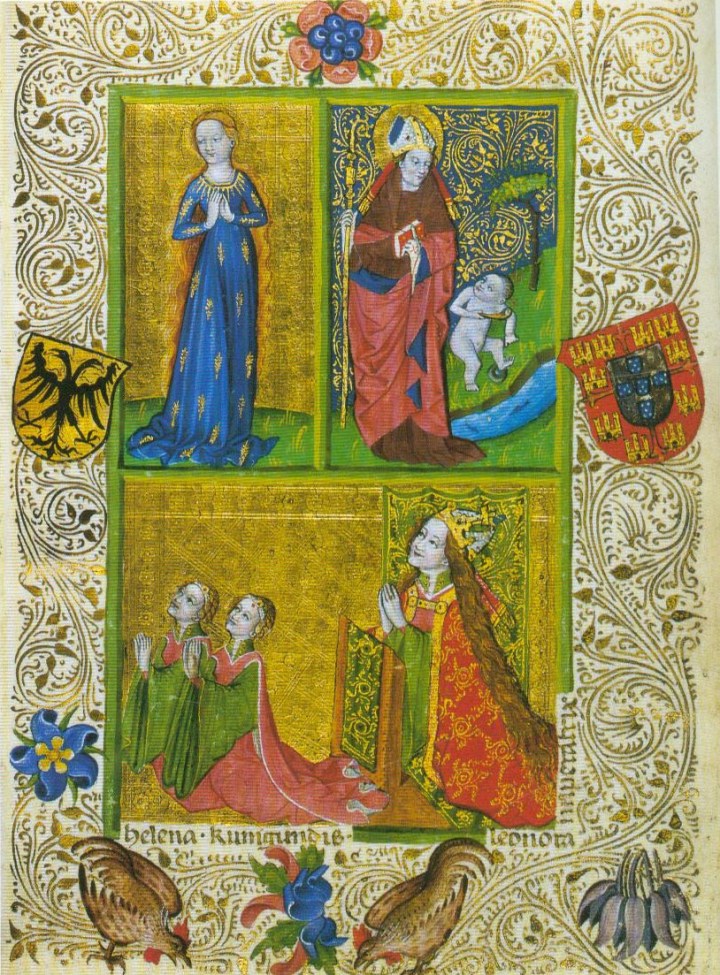by Heather R. Darsie
On 3 September 1467, Empress Eleonore Helena passed away. Born on 18 September 1434 as Eleonore d’Aviz of Portugal, she was not quite thirty-three years old when she died. Eleonore was one of nine children, the sixth born overall, and one of five daughters. Two brothers and two sisters survived to adulthood along with Eleonore. Eleonore was the eldest surviving daughter, though none of the Aviz children lived past the age of fifty.

Eleonore Helena of Portugal, copy of the original by Hans Burgkmair, via Wikimedia Commons.
Little Eleonore’s father died of Plague in 1438 when Eleonore was not quite four years old. His death caused a struggle for the regency of Eleonore’s eldest brother. Eleonore’s mother and paternal uncle both tried to seize control, with her uncle ultimately winning. Eleonore’s mother fled into exile in 1440, bringing only Eleonore’s sister Joanna with her. Eleonore was ill at the time, so her mother abandoned Eleonore to be raised at Eleonore’s brother’s court.
Several matches were arranged for Eleonore once she was of marriageable age. In 1448, Frederick von Habsburg sent his ambassadors and a painter to the Portuguese court so he could be informed of Eleonore’s appearance and character. The entire process took quite some time, allowing for the French to present a possible marriage candidate for Eleonore. Eleonore preferred to marry Frederick von Habsburg, an Austrian Archduke, because he would likely become the next Holy Roman Emperor. Frederick became King of the Romans in 1440, meaning that he was essentially the Emperor-elect. Eleonore liked the idea of being an empress more than of being a queen over a territory like France.
After two weeks of negotiations in Naples, the terms of the marriage were confirmed. Eleonore and her massive dowry were sent via ship to the port of Talamone, Italy. Her arrival was anticipated for 1 November 1451, but a series of storms and assaults by pirates broke up the Portuguese fleet. Only one ship made it to Talamone, and Eleonore was not on it. To make matters worse, none of the crew knew if the other ships remained intact, let alone where Eleonore’s ship was. Rumors of her death spread.
Eleonore finally made it safely to land, and the couple met in Sienna. Frederick was nineteen years older than Eleonore. The couple did not get along, despite their best efforts. Frederick found Eleonore attractive, but was worried about her ability to safely deliver babies given her slim figure. Despite his initial misgivings, the grand marriage went forward on 16 March 1452 in Rome. Three days later, the couple’s imperial coronation was held, and Pope Nicolas V gave Eleonore the name “Helena.” Eleonore never went by the name “Helena” during her life. Eleonore was the last Holy Roman Empress crowned in Rome.
Eleonore’s home life was full of struggle, as her husband criticized the Portuguese foods and customs which Eleonore preferred. The purging of Eleonore’s Portuguese entourage from the Austrian court left her feeling quite homesick. As was not uncommon in the 16th and other centuries, Eleonore was forced to an extent to eschew her cultural and linguistic upbringing to assimilate with her husband’s. Eleonore’s strong personality frequently conflicted with that of her husband, too. She was more adventurous and outgoing than he, as well. Her rambunctious spirit and their age difference did not improve their relationship as time wore on.

Eleonore Helena of Portugal with two daughters, Helena and Kunigunde. From the prayerbook of Frederick III, via Wikimedia Commons. Helena lived from November 1460 to February 1461, while Kunigunde was not born until March 1465.
Despite her unhappy marriage, Eleonore went on to have at least five children; three boys and two girls. There is scant mention of a possible sixth pregnancy. Every other one of Eleonore’s children died within six months of birth. Her second child and second son, Maximilian, went on to become the Holy Roman Emperor Maximilian I. Her fourth child and second daughter, Kunigunde, became the Duchess Consort of Bavaria-Munich. Eleonore’s son Maximilian I and great-grandson Charles V went on to become two of the most powerful European rulers during the 15th and 16th centuries.
Eleonore Helena died on 3 September 1467 in Austria, likely of a gastro-intestinal infection. She was fifteen days shy of thirty-four years old.
Are you interested in Tudor history or Women’s history? Want to know more about Anna of Cleves? Love learning about the Queens of England? Then check out my book, Anna, Duchess of Cleves: The King’s ‘Beloved Sister’, a new biography about Anna of Cleves told from the German perspective!
Please check out my new podcast, Tudor Speeches.
You Might Also Like
- Elector Johann Friedrich: Anna of Cleves’ Powerful Brother-in-Law
- Wilhelm V, Anna of Cleves’ Brother
- How to Train Your Hawk: A 15th Century English Prioress’ Guide
- Dashing through the Snow: Dangers of Alcohol Consumption in Reformation-Era Augsburg
- Philippa of Hainault
Sources & Suggested Reading
- Zierl, Antonia. Kaiserin Eleonore und ihr Kreis. Eine Biographie (1436-1467). PhD dissertation from the University of Vienna, unpublished (1966).
- Fuchs, Franz, Paul-Joachim Heinig, and Martin Wagendorfer. Koenig und Kanzlist, Kaiser und Papst: Friedrich III. und Eneo Silvio Piccolominiin Wiener Neustadt. Boehlau (2013).


Absolutely fascinating, I love to hear about women during this time period, as often the impression given is that they were all meek and mild and lacking any personality. Keep up the great writing!
LikeLiked by 1 person